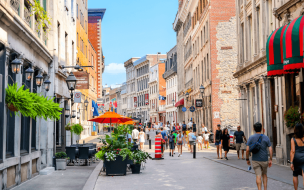Combined pressures from customers, employees, investors, and regulators, are forcing companies to promote sustainability and reduce the damage they do to the planet and its people.
Plus, McKinsey research shows sustainable leaders who drive green growth not only increase the chances of survival for their business but may also drive larger profits and create greater business opportunities.
So what exactly is green growth and how can you apply a successful green growth strategy?
What is green growth?

According to Luciano Barin Cruz (pictured), a leading sustainability expert and professor of Corporate Social Responsibility (CSR) at HEC Montréal, green growth refers to the fostering of economic growth on a sustainable basis.
The full-time MBA at HEC Montréal is ranked among the 30 best sustainability MBA programs in the world by Corporate Knights, and integrates green growth and CSR across the curriculum.
“It’s still a challenge to reduce our emissions, but we also need to consider how we can reconstitute the damage we have done. Green growth is about growing by respecting the environment,” Luciano explains.
By achieving green growth, organizations can support the shift to a green economy, moving away from the ‘take-make-waste’ linear model to one that can improve well-being and build social equity while reducing environmental impact.
There are three key players in a green economy: sustainable finance, sustainability-focused governments, and sustainable businesses.
So how can you implement a green growth strategy and build a sustainable business?
3 ways to implement a green growth strategy
1. Consider the environmental impact of your business operations
The first step in ensuring economic growth on a sustainable basis is to minimize the negative environmental as well as the social impact of business operations in your supply chains, Luciano explains.
This can be achieved through the decarbonization of supply chains, moving away from fossil fuels to renewable and clean energy sources, decreasing carbon emissions.
On the social side, companies should ensure suppliers pay workers a fair wage, health and safety regulations are followed, or that child labor has been eradicated.
“It’s also about how you can regenerate and grow at the same time,” Luciano says. “Green growth is about having a business model that allows us to regenerate nature that has been damaged.”

2. Adopt a regenerative business model
Unlike the ‘take-make-waste’ linear model, a regenerative or circular business model finds strategies for waste value creation.
Luciano gives the example of circular economy initiative, Loop Mission, which started producing fresh-pressed juices after being approached by a Quebec fruit and vegetable importer that wanted to create value from its food waste.
“They realized they could reuse 1.5 kilos of fruit and vegetable waste,” Luciano notes. “Then a big brand that makes bread approached Loop Mission and asked them what they could do with their leftover bread. Loop started producing beer and mixing in the fruits and vegetables.”
By adopting a regenerative business model, a business can optimize its natural assets to drive greater profits and support the shift to a circular economy.
HEC Montréal, Luciano explains, is leading research efforts in the field, with seven professors from the school taking part in the Quebec Research Network on the Circular Economy, a consortium that aims to develop training and education focused on the circular economy.
3. Focus on your local community
Sustainable businesses also champion inclusivity and look to create value for local communities.
Luciano says the local community were involved in the construction of HEC Montréal’s new building in downtown Montréal, opening in fall 2022.
The building was conceived to be regenerative by nature, leveraging green roofs and geothermal energy. This will reduce the building’s overall emissions, keeping pollution levels low in the city.

HEC Montréal's new building in downtown Montréal, opening in fall 2022.
What MBA skills do you need to achieve green growth in your business?
Business schools like HEC Montréal are working to ensure future leaders have the tools they need to master green growth and build sustainable businesses.

Valerie Dulude (pictured), an MBA student at HEC Montréal and VP of CSR for the MBA Student Association, has over seven years of experience in the field of sustainable development and agriculture as a consultant.
She chose to do an MBA to hone her leadership skills and obtain a managerial role in CSR consulting post-graduation. She says HEC Montréal was the right choice for her as the curriculum integrates sustainability into every MBA class.
“You have to be a generalist and a strategist able to integrate environmental and social considerations into every aspect of a business,” she explains.
MBA courses offered by HEC Montréal include Sustainable Development and Environmental Management, Sustainable Supply Chain, Responsible Marketing, Ethics in Finance, and Contemporary Issues and Social Responsibilities.
Students also have access to student clubs focused on sustainable development—including HumaniTerre, groupe NOVA, and HECOresponsable—where they collaborate with their peers and put theory into practice by working on various sustainability projects.
For Luciano, the key skills you need to drive a green growth strategy include analytical skills, critical thinking, and adaptability.
“You also need to be a visionary; to start moving business in another direction,” he says.
“You may not know what the solution to the problem is, but if you start working on it today, you start the collaboration, technologies may start to be created, and eventually we can come closer to finding the correct solutions.”








